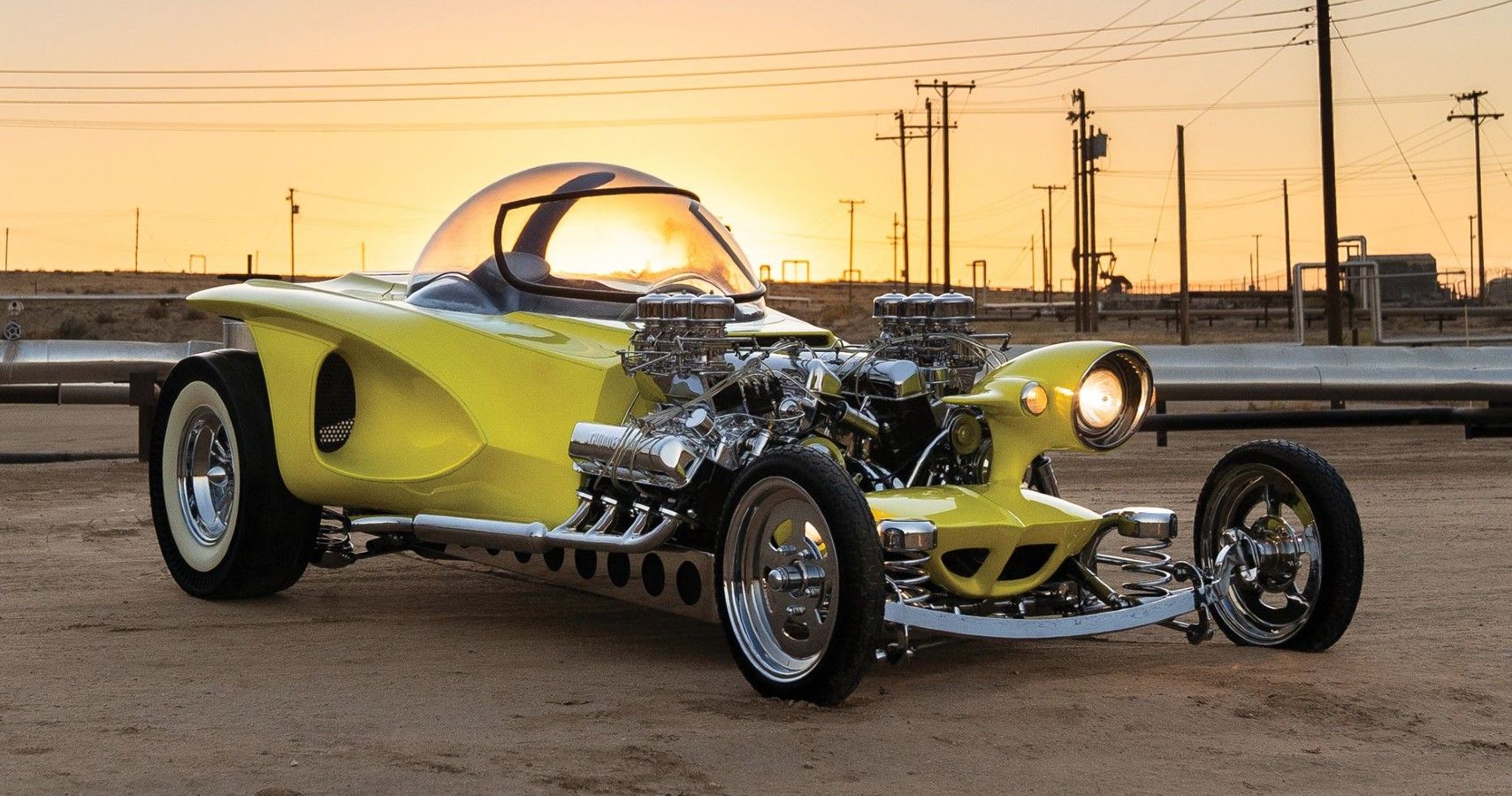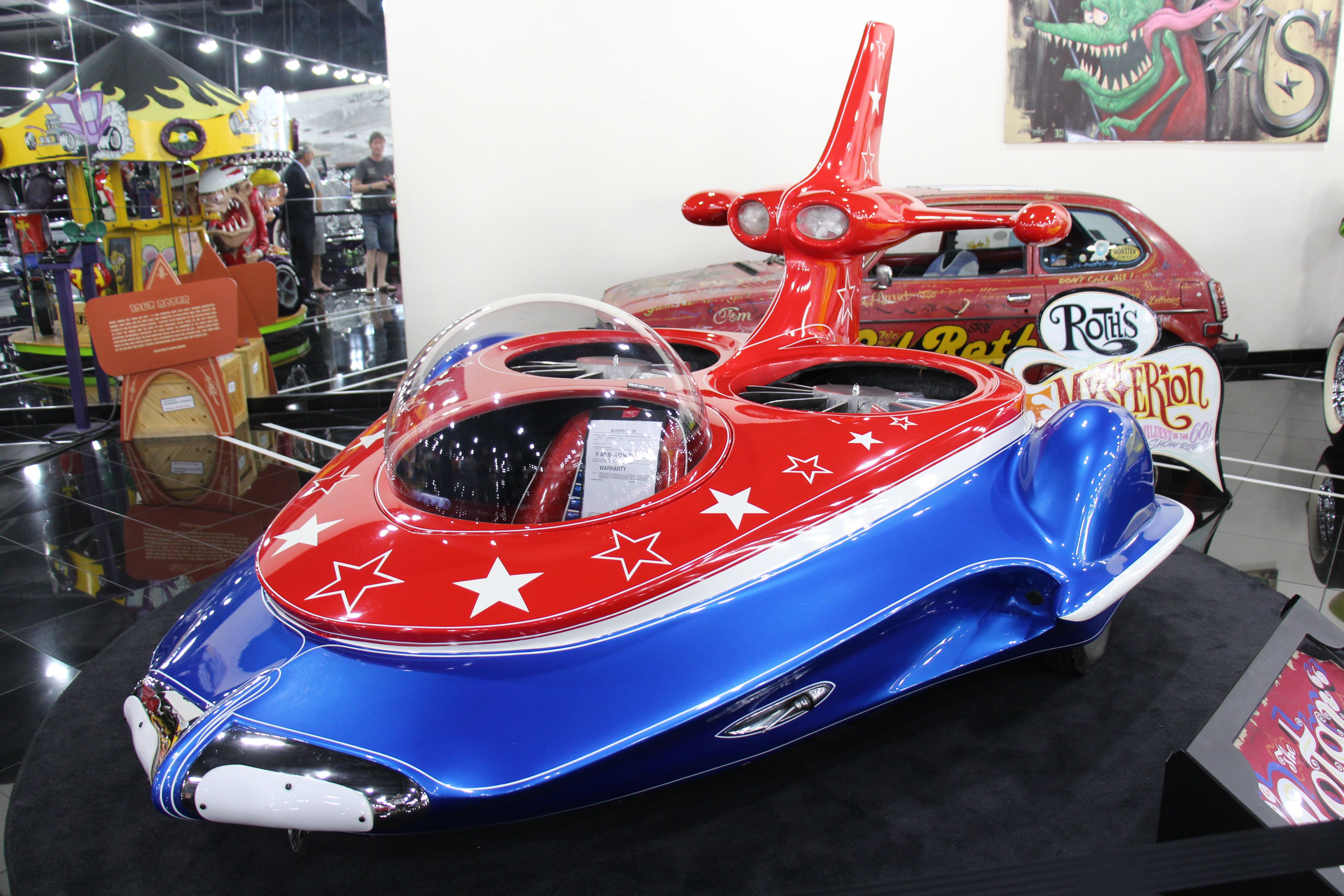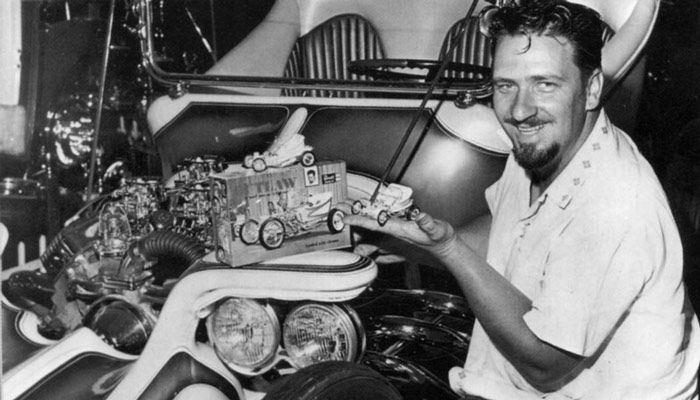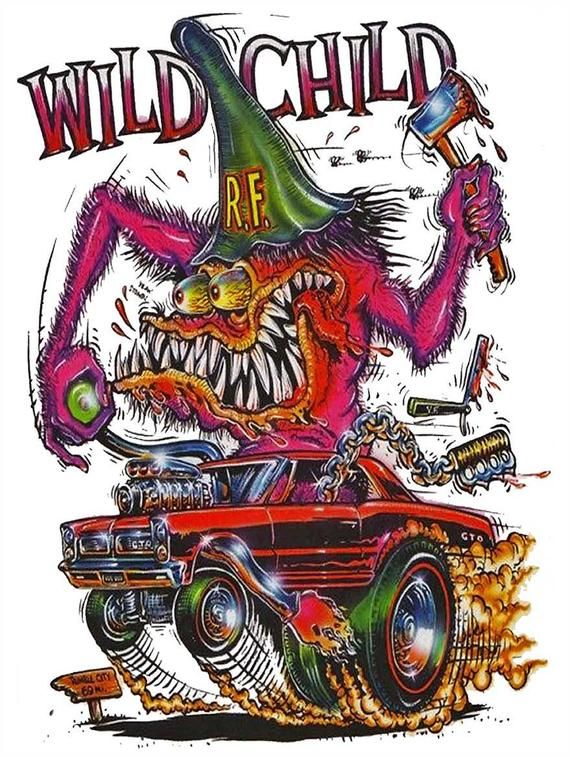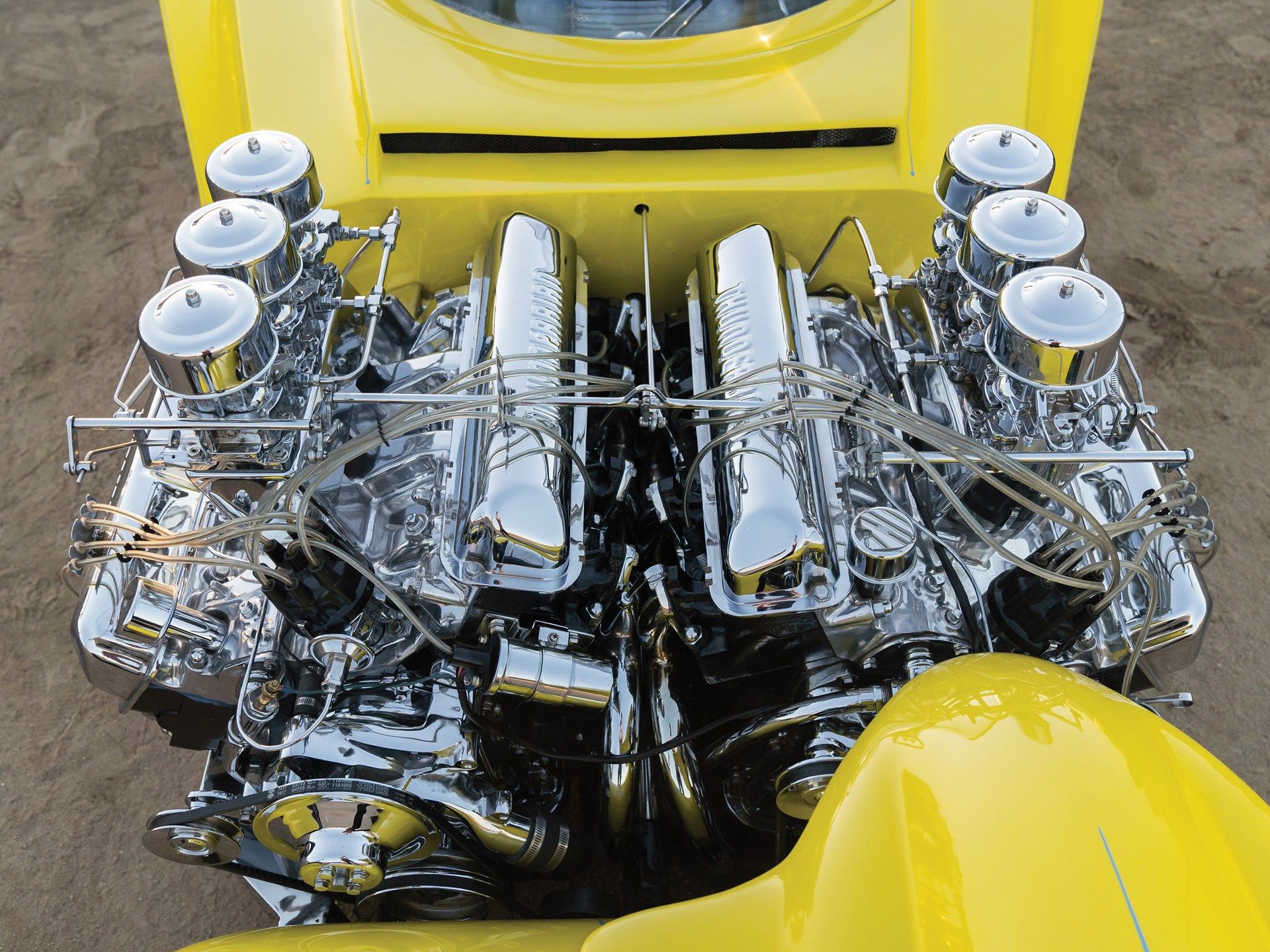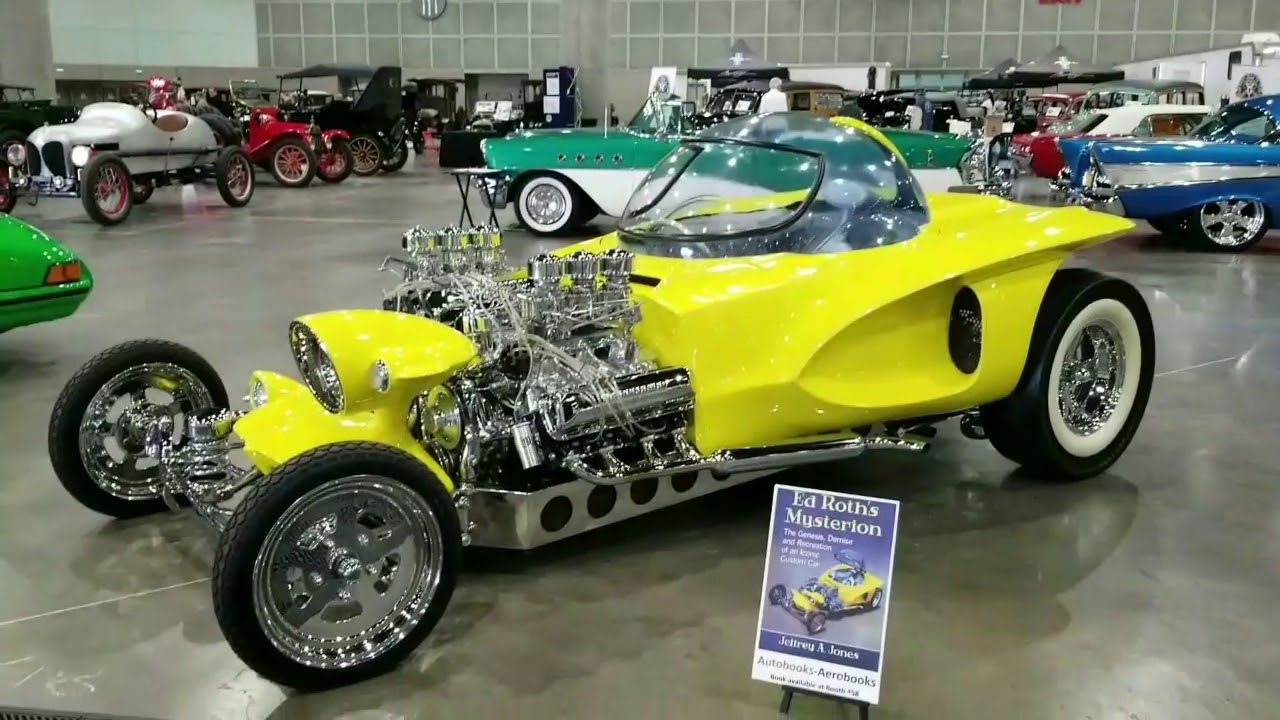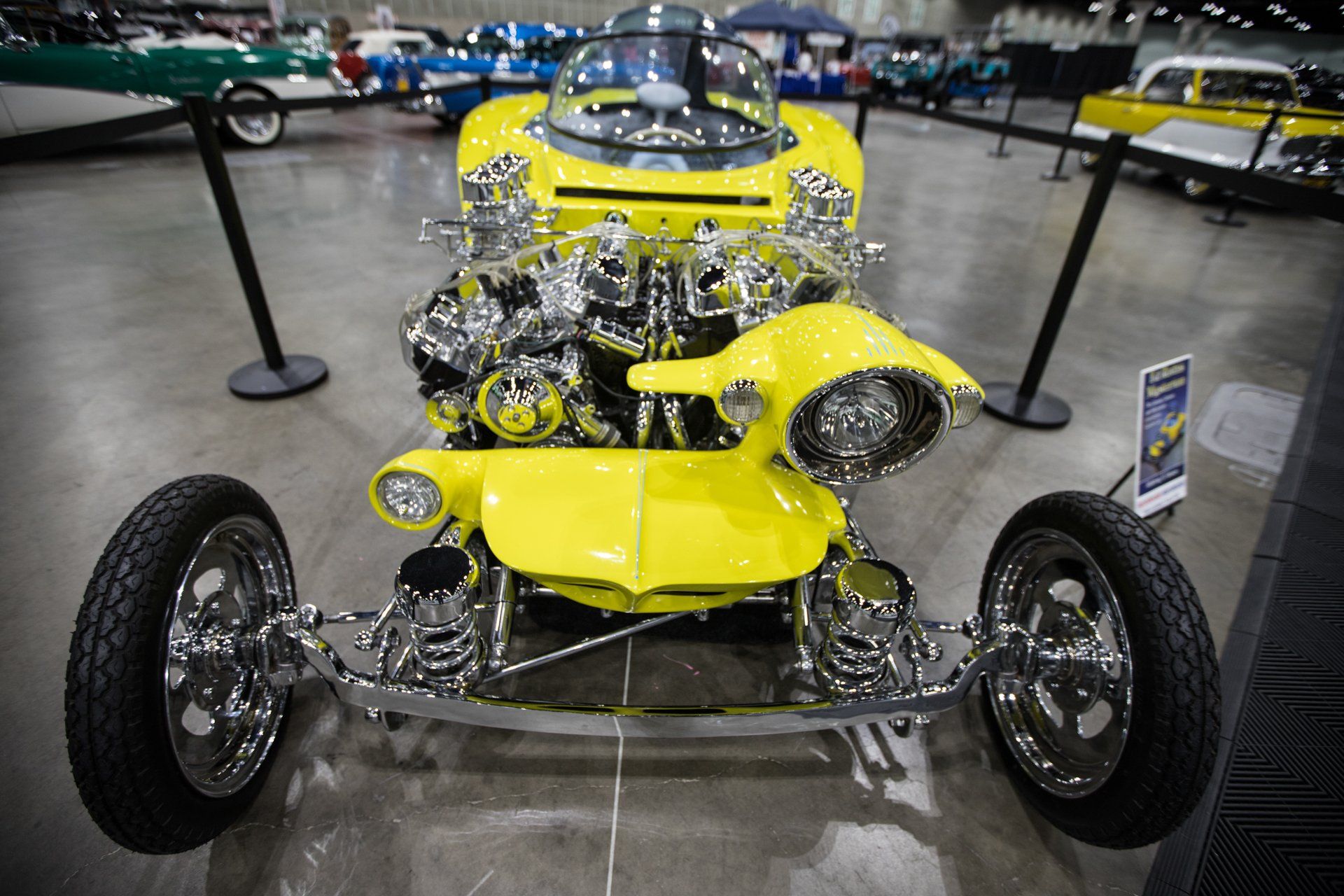The name Mysterion seems appropriate for Ed Roth’s hot rod creation not only for the car’s two engines and bizarre single cyclops-eye headlight but also for the mystery surrounding the show car’s disappearance.
Ed "Big Daddy" Roth built the Mysterion in 1963, one of several custom cars he created during the sixties. According to Auto Evolution, it was “an era of reckless excess and flashiness, the emergence of libertine and “free” attitudes, as well as counterculture… the sixth decade of the twentieth century also meant the rise of the Kustom Kulture and Hot Rod movement in Southern California.”
The colorful and larger-than-life car cult figure Ed “Big Daddy” Roth was a key figure in the SoCal car culture. Tom Wolfe once called him “the Salvador Dali of hot rodding.” His unique style is demonstrated in several other outrageous creations, including:
Orbitron
Roth's Orbitron was a tribute to the state-of-the-art technology of color television. The street-legal vehicle featured three colored headlights that combined to create a white light beam for night driving.
Rotar
The Rotar is more hovercraft than car, but it never flew. In 1964, at a car show in Detroit's Cobo Hall convention center, the Rotar's turbine was revved too fast, causing a fan failure. The Rotar was retired before it had the opportunity for a flight test.
Great Speckled Bird
The Great Speckled Bird was built for the desert. Equipped with an air-cooled Volkswagen engine and automatic transmission, Roth added a water tank and modified windshield washer sprayer to keep him cool during the ride.
Beatnik Bandit
The Beatnik Bandit used a joystick to control steering, acceleration, and braking. Roth’s creation is arguably the world's most widely recognized custom show car.
Tweedie Pie
The Tweedy Pie is an anomaly among Roth’s creations, a fairly typical hot rod, built with the chassis and body of two different Ford Model Ts. The Tweedy Pie made the cover of Rod & Custom magazine, but the car is best known as the Revell model kit version, of which over 11 million have been sold.
Here is a detailed look at Ed Roth and arguably his best work, the Mysterion.
Ed "Big Daddy" Roth was more American Artist than Custom Car Designer
Born in Beverly Hills on March 4, 1932, Ed “Big Daddy” Roth grew up an average student but focused on drawing monsters, airplanes, and hot rods. Roth’s father was a German cabinet maker, and Ed spent hours in the workshop learning how to build crazy mechanisms out of wood.
Roth studied engineering in college, hoping to gain some knowledge of automotive design, but he left school before graduating and joined the Air Force, where he learned how to make maps.
After his honorable military discharge, Roth worked with Bud “The Baron” Crozier, opening a shop called The Crazy Painters. During the mid-1950s, he painted customized cars, accent flames, and became well-known as a successful pinstripe artist who had a close connection with the hot-rodding world. Roth also began creating his crazy vehicles in his garage using junkyard parts and a newly developed product called fiberglass.
Roth’s built his first car, the “Little Jewel,” followed by the “Outlaw,” the “Beatnik Bandit,” and “Rotar.” His creations demonstrated that designing and building a car did not require a degree in automotive engineering. Imagination, some mechanical knowledge, a lot of hard work, and desire were the essential requirements.
Ed “Big Daddy” Roth had become a hot-rodder, crazy scientist, and an aspiring artist, who financed his inventions by selling t-shirts and drawings and at fairs, drag races, and car shows. His drawings of cartoon monsters and cars were popular with his fans, but at shows, where he personally airbrushed t-shirts with the monsters driving cars, long lines of enthusiasts often formed at his booth.
Ed “Big Daddy” Roth’s monster, Rat Fink, became his most popular cartoon character. Although he was a genius crazy-car designer, it was the Rat Fink figure that brought him fame. By 1963, teenagers across America were buying mass-produced Rat Fink T-shirts and building Rat Fink model kits by Ed “Big Daddy” Roth.
The Mysterion Proved Two Engines Are Better Than One
John Gilbert, of Automobile Magazine, wrote: "Big Daddy Ed Roth built the fun stuff, the sort of wild and whimsical cars that tickled the fancy and pickled a kid's imagination for life.”
The legendary twin-engine Mysterion perhaps represents Roth’s vivid imagination better than any of his other wacky creations.
Roth got the idea for dual engines from dragsters, some of which had two, three, and even four engines. He initially installed two 1950 Oldsmobile V-8 engines connected to Hydromantic transmissions but later replaced them with brand new donated Ford Thunderbird 390-cubic-inch V8s. The frame was made of steel, but the wall thickness was too light to support two heavy Oldsmobile or Ford engines, and the structure eventually cracked.
Roth never built one of his cars with a steel body. His medium of choice was fiberglass laid up with a plaster mold. He sculpted the iconic cyclops eyeball headlight of the Mysterion using the same method.
Hydraulics were used to adjust the rear suspension height and to open and close the Mysterion’s bubble top. Everything on the car was chromed, including the chassis.
The build was completed in 1963 after the Watson's House of Style painted the car Candy Yellow. Rod & Custom featured the Mysterion in full color on the cover of the September issue, even though the car did not run.
The Mysterion’s Tours and Eventual Demise
Ed Roth discovered that the Mysterion and other crazy car creations helped generate revenue from his artwork at car shows. He was invited to display his cars often with his show expenses paid by the promoters. His wild “Rat Fink,” a.k.a. “Mickey Mouse’s evil twin,” captivated worldwide audiences, and many of his fans purchased Rat Fink T-shirts and other themed gear at the shows.
Roth took the Mysterion to several shows before deciding to rent the car to show promoter Bob Larivee. While the two-engine creation was being toured by Larivee, he discovered a crack in the frame, caused by the stress of two heavy engines on the thin-walled chassis.
Roth asked Larivee to remove both front and rear axles and wheels, ship them back to Maywood, and pay for the damage. However, when no payment was made, the car, with the crankshafts and pistons removed, ended up in a Tulsa garage.
Doug Wright discovered the remains of the Mysterion alongside a wall inside Ray Farhner's shop in Raytown, Missouri, which he purchased for $750.
Although the car had no title papers, Doug planned to restore the car and put it back on the road, but it never happened. After three years languishing in his basement, he stripped the Mysterion down to its parts and sold them. A body shop in Independence, Missouri, purchased the body and frame.
Jeffery Jones Builds a Mysterion Replica
Despite its disappearance, the Mysterion lives on!
Jeffery Jones tackled the task of creating an exact replica of the two-engine beast, an almost insurmountable undertaking since there were no design drawings or specifications available. Furthermore, he wrote a book, “Ed Roth's Mysterion, subtitled The Genesis, Demise, and Recreation of an Iconic Custom Car,” describing the entire process.
Jones began by tracking down facts, photos, and part specifications. Roth's body construction medium of choice was fiberglass laid up inside a plaster mold. Jones followed the same technique. In his book, he goes to great lengths explaining how he determined the proper dimensions and how he replicated the molds, and the type of fiberglass used.
Jones knew the weak frame could not be replicated exactly if his Mysterion version was to move under its own power without collapsing. He described Roth’s chassis as a work of art, but a design with fatal flaws from the beginning.
Jeffrey Jones’ Mysterion sold at Sotheby's, The Petersen Automotive Museum Auction on December 8, 2018, for a price of $246,600, double the expected amount. Notwithstanding the high sales price, Jones most likely made no profit after deducting the cost of materials and the amount of time he poured into the project.
The Mysterion replica is now part of the Stahls Automotive Collection in Chesterfield, Michigan.
Sources: rodauthority.com, hemmings.com, cruisnews.com, hotrod.com, ratfink.com

